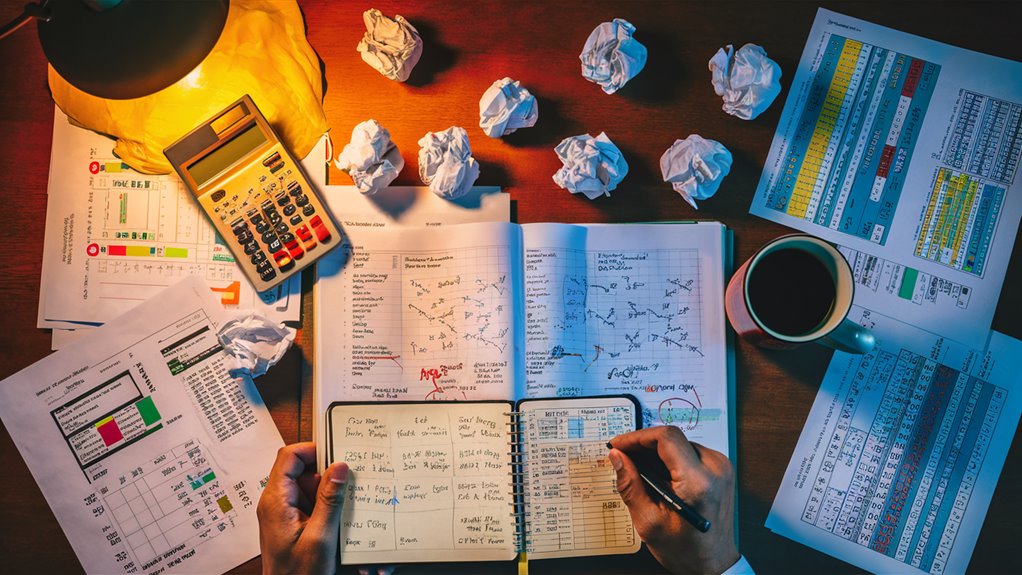Table of Contents
ToggleThe Simple Math Behind Sports Betting

Looking at the Numbers
Winning at sports betting relies on basic math and number checks. Studies show that just 2-3% of betting chances truly have a good expected value. Knowing chance rules is key for long-term wins.
Key Factors for Success
To make steady profits, you must win at least 54% of your bets to beat the usual -110 odds. Top bettors use firm money rules, putting only 1-3% of all money on a single bet to reduce risk.
Deep Number Skills
To win at sports betting, you must be good at:
- Checking patterns
- Watching line changes
- Making models
- Figuring out ups and downs
- Checking chances
Getting the Math Right
Knowing these simple math ideas helps many casual bettors avoid losing money. If you get good at using numbers well, stick to solid checking plans, and always make choices based on data, you can find real ways to win money.
What Pros Need
Long-term wins depend on: https://maxpixels.net/
- Methodical checks
- Full data tracking
- Deep chance math
- Rules for risk
- Finding numerical edges
The Basics
How Basic Chance Rules Work
Main Ideas of Chance
We use chance rules to understand unsure events, with chances from 0 (can’t happen) to 1 (will happen). Knowing these basic rules lets us make smart choices in many areas.
If Events Are Tied or Not
Events that stand alone happen without affecting what comes next, like flipping a coin. Tied events, though, show links where past results change what might happen next. This is key when we face complex chance settings.
Must-Know Calculations
The Math Rule
For stand-alone events, the rule says:
P(A and B) = P(A) x P(B)
If B Then A Chance
For tied events, we look at:
P(A|B) = P(A and B) / P(B)
Real-Life Uses
Knowing how to calculate chances helps us check real-life events better. Imagine you have a 60% chance at a thing happening, then the chance of it happening twice is 0.6 x 0.6 = 0.36 or 36%. This basic math tool helps us sort out tough chance settings and make choices based on numbers.
Core Math Ideas
- Chance range: 0 to 1 (0% to 100%)
- Stand-alone events: They don’t mix.
- Tied events: One leads to another.
- If this, then that chance: How events link.
- Step-by-step chance: Math for more than one event.
What’s Expected Value?
Expected Value in Sports Betting
What’s Expected Value?
Expected value (EV) is the average result after many tries in betting. This simple math idea helps bettors work out likely profits and make smart bets.
How to Find Expected Value
The main expected value formula is:
EV = (Chance of Win x Money Won) – (Chance of Loss x Money Risked)
An Example
Think about a $100 bet at +150 odds and a 40% chance to win:
- Win Calc: 0.40 x $150 = $60
- Lose Calc: 0.60 x $100 = $60
- Final EV: $60 – $60 = $0
Understanding EV Results
- Positive EV points to good bets
- Negative EV shows bad bets
- Zero EV means you break even
What to Think About With EV
- Guessing chances right: You need to know the real odds.
- Think long-term: Focus on results over many tries, not just one go.
- Handle risk: Know that, even with positive EV, things can wobble.
- Manage money: Use EV to figure how much to bet.
This tool is key for pro sports bettors, letting them choose based on data, not just guesswork.
Deep Stats in Sports Betting
Deep Stats in Sports Betting
Understanding Key Stats Methods
Stat analysis builds the base for good sports betting plans, turning large data sets into useful betting ideas. Regression checks are key in spotting links between many things, like how a team does, the weather, and past bets. Top guessing methods help bettors work out win chances better than plain old guessing.
Checking Shifts and Spotting Deals
Figuring out changes and typical swings give key hints on betting market moves. Using z-score checks for team numbers shows big odd ones out and good bet chances often missed by most bettors. Bayesian chance methods make predictions better by adding new data all through the sports seasons.
Timing and Risk Tools
Time checks are key in today’s betting ways. Keeping an eye on moving averages and momentum numbers, mixed with deep Monte Carlo tests, helps tell how unsure bets are. This deep check plan, mixed with firm money rules, builds a solid math base for lasting betting wins.
Key Stats Tools for Betting
- Regression Plans
- Change Checks
- Bayesian Guessing
- Z-Score Math
- Monte Carlo Tests
- Time Checks
Money Tips and How to Handle It Right
Tips on Money and How to Manage It in Betting

Basic Money Rules
Smart money handling is the core of keeping betting wins going, more than just being smart or guessing right. The best first step is to use 2-5% of spare cash as your set money, while using smart methods like the Kelly Rule or part Kelly way.
How to Size Your Bets Right
Keeping firm bet-size limits between 1-3% of all your money keeps you safe from big swings and helps your money grow in the long run. For a $10,000 money pile, usual bet amounts should be $100-300, no matter how sure you are about the result.
The Formula to Get It Right
The smart way to tune your money uses this formula:
- Best Bet Size = (bp – q) / b
- Where: b = odds
- p = guessed win chance
- q = 1-p
This math maximizes expected value over time. Even with a 60% win rate on usual -110 odds, bad money handling can eat your money, while good sizing turns the same win rates into steady profits.
Main Money Rules
- Set a clear start money
- Keep to set bet size rules
- Work out the best bet sizes using math
- Stick to the plan no matter how sure you are
- Watch and change your plan based on how you do
The Math Behind Setting Odds
The Math That Sets Betting Odds
Grasping True Chances and Odds Math
The base of setting odds stands on deep math ideas and advanced chance rules. Bookies use complex stats models to set fair prices that show true event chances while keeping margins that let them make money.
Stats and Mixing Data
Pro odds setters use lots of data points to work out right chances:
- Past playing numbers
- Team and player stats
- Head-to-head matchup info
- Situational points
- Weather facts
- Injury news
Turning Chances into Lines
When setting betting lines, a worked-out chance turns into certain odds. For instance, a 60% win chance turns into:
- Fave: -150 odds (risk $150 to win $100)
- Underdog: +130 odds (risk $100 to win $130)
The Part of Vig in Setting Odds
Vig (or “vig”) is the bookie’s built-in fee, usually 4.55% on usual -110 lines. This math tweak makes sure they make money no matter how the bets go, while keeping prices that draw bettors.
How Lines Move and Market Works
Sharp betting shifts lines through:
- Finding math weak spots
- Fixing market tools
- Changes based on how much is bet
- What pros are doing
Digging into Betting Markets
Getting Betting Markets
Market Action and How It Works
Betting markets act like deep money places where odds shifts react to lots of things like market force, what people think, and math chances. These markets line up well with market smart theory, as price tools quickly take in new info to tweak odds.
Market checks focus on three key numbers: market smarts, line moves, and last line value.
Main Things to Check
Checking market smarts uses the link between start odds and end odds, with small changes showing very smart markets. Line move checks give key hints on where sharp money goes versus what the crowd bets, with pro bets often making bigger line moves.
Checking last line value (CLV) compares the odds you got to final market prices, providing a key number to evaluate your betting plan.
Chances in the Market
Stat bets provide unique opportunities when bookie odds show substantial differences across markets. Math models help identify market weak spots, particularly when odds gaps exceed combined edges.
Deep market checks reveal about 2-3% of betting chances have a good expected value, highlighting the need for careful selection for long-term success in betting markets.
Main Market Check Points
- Tracking odds links
- Finding sharp money
- Figuring last line value
- Looking at prices across markets
- Using stat models for bets
Changes and Long Wins
Understanding Changes in Betting Wins
Math Truths of Sports Betting
To win at sports betting, you need to understand both market checks and change handling. Even with good stats on your side, short-term results often deviate from expected values due to normal result changes.
A bettor hitting a 54% win rate on -110 odds must realize that wins don’t always follow a straight line.
Figuring Changes and How Much to Bet
Stat trust in sports betting requires substantial data. With bets of 100 units, about 400 bets give 95% confidence in true win rates. In this group, bettors will encounter many times of wins and losses. Deep math shows that skilled bettors with a 5% return should anticipate money dips of 20-30%, even with successful approaches. Unlock Hidden Casino Bonuses
How to Handle Changes
The Kelly Rule offers the mathematical way for optimal money management, suggesting 1-3% unit sizes per bet. This tested plan allows bettors to endure challenging times while growing money effectively. Long-term wins arise from expansive series of tries, highlighting why many good bettors falter by focusing too much on short-term outcomes and failing to recognize the impact of changes.
Must-Know Change Points
- Win Rate Swings
- Money Ups and Downs
- How Much to Bet Needs
- Risk Rules
